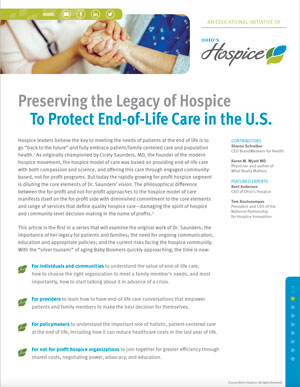
Is end-of-life care threatened by today’s healthcare environment?
Preserving the Legacy of Hospice To Protect End-of-Life Care in the U.S.
Hospice leaders believe the key to meeting the needs of patients at the end of life is to go “back to the future” and fully embrace patient/family-centered care and population health.1 As originally championed by Cicely Saunders, MD, the founder of the modern hospice movement, the hospice model of care was based on providing end-of-life care with both compassion and science, and offering this care through engaged community-based, not- for-profit programs. But today the rapidly growing for-profit hospice segment is diluting the core elements of Dr. Saunders’ vision. The philosophical difference between the for-profit and not-for-profit approaches to the hospice model of care manifests itself on the for-profit side with diminished commitment to the core elements and range of services that define quality hospice care—damaging the spirit of hospice and community-level decision-making in the name of profits.2
This article is the first in a series that will examine the original work of Dr. Saunders; the importance of her legacy for patients and families; the need for ongoing communication, education and appropriate policies; and the current risks facing the hospice community. With the “silver tsunami” of aging Baby Boomers quickly approaching, the time is now:
- For individuals and communities to understand the value of end-of-life care, how to choose the right organization to meet a family member’s needs, and most importantly, how to start talking about it in advance of a crisis.
- For providers to learn how to have end-of-life care conversations that empower patients and family members to make the best decision for themselves.
- For policymakers to understand the important role of holistic, patient-centered care at the end of life, including how it can reduce healthcare costs in the last year of life.
- For not-for-profit hospice organizations to join together for greater efficiency through shared costs, negotiating power, advocacy, and education.
The Legacy: How It All Began
Dame Cicely Saunders (1918–2005) was a British social worker, nurse, and physician who had a dream back in the 1950s that no patient should die alone and in pain. From her vision the modern hospice movement was born, significantly changing the way the medical community approached death and dying. Through her research and experience with dying patients, Dr. Saunders identified the essential components of the compassionate and evidence-based care she envisioned, including:
- Patient-centered, whole-person care
- Physician-patient communication
- Staff and provider education
- Research
These components are all relevant today as medicine—and society as awhole—struggle to find sustainable waysto improve care at the end of life and prepare for future challenges. As evidence of the relevance of these issues today, one only needs to look to the best-selling books by such experts as Ira Byock, MD, and Atul Gawande, MD, and the widely read and highly regarded reports from the Institute of Medicine and the Aspen Institute. The U.S. healthcare system, including hospice and palliative care, will be impacted by:
- A burgeoning elderly population estimated to increase to more than 72 million by 2030,3
- The cost of healthcare at the end of life,
- A projected physician shortage of as much as 120,000 by 2030,4 and
- A significant shortfall in the number and availability of paid and family caregivers that exists now and will only worsen in the near future.5
But the vital legacy of hospice in providing compassionate care for the dying faces another threat from within the hospice movement itself.
Since Dr. Saunders first opened the doors of St. Christopher’s Hospice in London in 1967, the hospice movement has spread throughout the U.S. with nearly 4,400 Medicare-certified hospices now in operation.6 Hospices in the U.S. initially were established as not-for-profit, community-based organizations with a mission to advance the values set forth by Dr. Saunders.
In those first years of the hospice movement in the U.S., these legacy providers relied upon charitable donations, fundraising and a great deal of volunteer labor and support to provide a holistic approach to care for patients, family members, and their communities.7
The past two decades, however, have seen a rapid increase in the number of for-profit providers in the hospice field—both publicly traded and privately held companies—with their numbers tripling between 2000 and 2012 while the number of not-for-profit providers has remained relatively static.8 According to a healthcare mergers and acquisitions firm, hospice is a “hot commodity” now as “investors are looking at the silver tsunami of aging baby boomers and want to have skin in the game.”9 In fact, care of the dying has blossomed into a multi-million dollar industry for for-profit companies and their investors10 as the for-profit sector has grown exponentially.
But recent research suggests that some for-profit hospices may be threatening the survival of the not-for-profit sector, diminishing the legacy of care envisioned by Dr. Saunders to seize an unfair advantage in the marketplace.11
This article examines the foundation of care envisioned by Dr. Saunders, provides an overview of the current challenges facing hospice, and assesses how preserving Dr. Saunders’ legacy can help meet these challenges. In addition, this article will examine recent studies analyzing the contrast between the for-profit and not-for-profit approaches to care of the dying.
Despite considerable progress, significant problems remain in providing end-of-life care for Americans that is high quality and compassionate and preserves their choice while being affordable and sustainable.12
FOUNDATION 1: Patient-Centered, Whole-Person Care
The hallmark of compassionate end-of-life care is to treat each patient as an individual, listen to his or her needs, and recognize that dying is not just a physical process but an experience of the whole person—and the family as well. This awareness of the needs of the whole person led to the well- known concept of “total pain,” which is one of Dr. Saunders’ greatest contributions to the hospice and palliative care body of knowledge. Equally important is caring for a patient throughout the entire end of life and not abandoning the patient as death approaches.
In keeping with Dr. Saunders’ vision, the 2015 Institute of Medicine Report, Dying in America, features a list of “Proposed Core Components of Quality End-of-Life Care,” which the Institute suggests should apply to care for all individuals as they near the end of life. The list includes management of pain and other physical symptoms as well as attention to the patient’s emotional, social, spiritual, and religious needs.13
But in sharp contrast to these components of quality care, “some hospices are making determinations of hospice coverage based solely on cost and reimbursement as opposed to being based on patient-centered need, preferences, and goals for those approaching the end of life,” according to regulators for the Centers for Medicare and Medicaid Services (CMS).14
In various studies, for-profit hospices have been found to provide a narrower range of services to dying patients than not-for-profits,15 including:
- Fewer visits from nurses during the last few days of life,16
- Less continuous nursing and inpatient care,17 and
- Fewer options for pain relief, such as palliative radiotherapy.18
In addition, for-profit hospices are more likely than not-for- profits to discharge patients before death (22 percent vs 14 percent), which, according to analysts, indicates a prioritization on profitability over quality patient care.19
The study results reveal the incompatibility of a hospice model based on profit maximization with the compassionate end-of- life care envisioned by Dr. Saunders. In fact, one investment analyst bemoaned the fact that profit margins in hospice are not yet as high as they could be because not-for-profit providers still “aim to fulfill their missions rather than turn a profit.”20
Yet according to Dr. Ira Byock in his book The Best Care Possible, end-of-life care that is patient-centered (rather than profit-centered for wealthy investors) actually can help lower healthcare costs. Byock quotes a Dartmouth Atlas study that “estimated that Medicare could reduce hospital costs by 28–43 percent by adopting the patient-centered, proactive approaches of the most efficient systems.”21 These cost savings are possible because patient-centered care often leads to fewer unnecessary tests and less unwanted treatment.
SUMMARY: “When patients and family members have control over the end-of-life experience and define quality and what is important to them—we are fulfilling the heart of hospice care and helping patients fully live until they die,” said Kent Anderson, CEO of Ohio’s Hospice.
“Not-for-profit organizations are dedicated to fulfilling the wishes of the patient—not just providing the basic care covered by Medicare, Medicaid, or other insurance benefits,” Anderson explained.
Preserving the concept of whole-person, patient-centered care to the entire healthcare system will reduce costs and ensure that patients’ needs are met at the end of life.
FOUNDATION 2: Physician-Patient Communication
There is a definite lack of physician-patient communication about death and dying, a conclusion supported by the Dying in America report, which named it “the most striking area in need of quality improvement”22 for patients nearing the end of life. If doctors and patients don’t talk about end-of-life choices, appropriate referrals for compassionate care don’t occur when they are needed.
In healthcare today, patients may receive the type of quality, compassionate care at the end of life as envisioned by Dr. Saunders if they are referred in a timely manner to a hospice that focuses on patient-centered care. The National Hospice and Palliative Care Organization23 (NHPCO), however, reports that in 2017, less than half of patients nearing the end of life were referred to hospice by their physician and most of them received care for just seven days or less. In addition, a recent survey24 found that only 16 percent of physicians reported having had end-of-life conversations with their patients.
“Fifty percent of patients are in hospice for 12 days or less. Twenty-five percent are in hospice less than three days— meaning costly curative treatments are taking place in the hospital setting. Research shows that quality of life improves and costs decline when patients are referred to hospice earlier. Most people want to die with peace and dignity in their home surrounded by loved ones—but this isn’t happening,” said Anderson.
Moreover, when physician-patient communication is poor, overtreatment can result. Dr. Byock writes: “Any doctor who dreads talking to patients about dying—and that describes a large majority—quickly learns that ordering more tests and treatments allows him or her to refocus on the disease and sidestep in-depth discussions with patients and their families about these morbid (or mortal) subjects.”25 Thus, the cost of care at the end of life increases when physician-patient communication is absent.
Hospices should encourage physician-patient communication by providing resources to the medical community.
Dr. Atul Gawande writes: “Our decision making in medicine has failed so spectacularly that we have reached the point of actively inflicting harm on patients rather than confronting the subject of mortality.”26
Hospices can do a much better job of encouraging physician- patient communication by providing education and resources to healthcare providers. Some for-profit hospices, however, are sidestepping the need to support and encourage this appropriate physician-patient communication. They have been reported for increasing their census by actively recruiting patients who may not have a life-limiting diagnosis, thus shifting financial resources away from the dying patients who need care to simply maximize their profits. Some of these for- profit organizations have been indicted for Medicare fraud after paying physicians to “certify patients as hospice eligible without examining the patient or reviewing medical records.”27
SUMMARY: When the profit motive takes precedence over the needs of the patient, everyone suffers the consequences. Returning to the foundations of hospice care will ensure that patients who need quality, compassionate end-of-life care can receive it in a timely mannaer.
FOUNDATION 3: Provider Education
Creating a positive culture in which compassion and science merge is rooted in providing education to physicians about care of the dying. Dr. Saunders encouraged her fellow physicians to find a “new criterion of success” in their treatment of patients and to recognize that dying in a peaceful manner can be viewed as a positive outcome for a patient. She also encouraged doctors to set aside the notion of “cure at any cost” and to focus on care instead. She admonished them not to desert their patients as they neared the end of life.28
In fact, education of providers and patients about end-of-life issues is likely the only way to improve communication and ensure that patients receive the care they want at the end of life. The Institute of Medicine recommends in Dying in America that all medical and nursing schools incorporate end-of-life and palliative care training into their curricula. In addition, the report advocates teaching communication skills to all medical students and residents.29
The Ungerleider Palliative Education Fund recently helped initiate a program at Sutter Health’s California Pacific Medical Center to increase medical training focused on advanced illness and end-of-life care as well as communication skills.30 The goal is to see this kind of innovation replicated in other medical schools and to include rotations on hospice and palliative care services during residency training.
The Aspen Institute, as one of the its “Five Big Ideas to Improve Care at the End of Life,” also encourages the integration of palliative care into all health professional training and an expansion of “the types of professionals, including community- based workers, who can play a role in providing patient- centered end-of-life care.”31 This goal is currently being met through the movement to incorporate end-of-life doulas into hospice care, which has been endorsed by the NHPCO32 and holds promise for helping to alleviate the anticipated shortage of providers and caregivers in the future.
But a study reported in the Journal of the American Medical Association (JAMA) shows that for-profit hospices are less likely to provide training and education than not-for-profits. The JAMA study presumes that this is so because the cost of such education doesn’t align with for-profit providers’ revenue goals.33 This is alarming considering that even more training programs will become necessary in the future to cope with the coming physician shortage.
SUMMARY: Ongoing education and training for community members in addition to hospice personnel is part of the legacy of hospice. To preserve this vision there should be a renewed focus on not-for-profit, patient-centered care that is committed to overcoming shortages of providers and caregivers through education.
To overcome future provider shortages, education in end-of-life issues is necessary for doctors, lay providers, and patients.
FOUNDATION 4: Research
Scientific research on pain management and best practices of care for the dying are key components on which the hospice movement was built. Dr. Saunders combined scientific rigor with the wisdom gained at the bedside of her patients to constantly improve the quality, compassionate patient care she was dedicated to delivering.34
While she read and shared research findings with other advocates to advance knowledge about end-of-life care, Dr. Saunders still valued the uniqueness of each organization that provided care for the dying. She resisted “franchising” her hospice concept because she believed that every community should create—with the help of her research—a specific plan to meet the needs of its own patients.35
Her belief provides an important caveat for the current healthcare system: focus on community-based answers for the universal problem of caring for the dying. For example, the obstacles and potential solutions for providing hospice and palliative care in rural areas differ from those found in urban centers and therefore need to be addressed with different models of care and provider structure. Future research will have to take this fact into account.36
In accord with this principle, the Dying in America report advocates “practice-based research networks”37 to generate relevant and effective data for individual communities. This model links academic centers to primary care practices to allow for exchange of information and insights.
The report further highlights the need for additional research in several areas, including how to avoid unwanted care, how to improve quality of life, how to meet the needs of family caregivers, how to improve the accuracy and timing of prognosis, and how to develop evidence-based quality measures of end-of-life care.38
The Aspen Institute similarly has called for developing quality metrics that can be used to evaluate all aspects of end-of- life care. It has emphasized the need to learn from “model communities” that are already meeting the needs of patients at the end of life.39 Some of these model communities include Grand Junction, Colorado, where healthcare costs have been kept low without sacrificing quality;40 La Crosse, Wisconsin, where 98 percent of residents have completed an advance directive;41 and the state of Minnesota, where referrals to hospice have tripled since 2000.42
These recommended research projects have the potential to yield significant progress in end-of-life care by focusing on areas of greatest need for patients, families, providers, and communities. Studies show, however, that for-profit hospices are less likely than not-for-profits to participate in such research43 as they emphasize profit-centered care.
SUMMARY: It is essential for the healthcare system to devote adequate time, energy and money to the scientific approach to care at the end of life to ensure that the quality, compassionate care for which hospice is treasured is made available to all individuals at the end of life.
Timely and appropriate research is essential for the ongoing evolution of hospice and palliative care and to meet the goal of helping every patient die with comfort and dignity.
SUMMARY
Dame Cicely Saunders’ legacy of merging compassion and science—heart and mind—must be preserved because neither facet alone is sufficient to meet the challenges the healthcare system faces in caring for the dying. Compassion alone cannot sort out the best methodologies of patient care. And scientific study that lacks compassion fails to protect the dignity and humanity of the patient.
“Few of us have escaped the chaos of our current system, myself included,” said Tom Koutsoumpas, president and CEO of the National Partnership for Hospice Innovation. “My personal passion is driven by my mother’s experience, who, for almost five years, lived with multiple chronic conditions, visited the ER and the hospital on countless occasions; it became almost impossible for her and for our family. Late at night, answers did not come quickly. It often required an ER visit or hospital stay.
“With 10,000 baby boomers newly eligible for Medicare every day, many of whom will have or have advanced illness, we must find a way to provide quality care to this population—or fragmented care and cost will continue to spiral out of control. I often say we need to go back to the future by providing care where patients want it—in the home up until the end of life,” Koutsoumpas said.
The four areas of emphasis covered in this paper are:
- Patient-centered, whole-person care
- Physician-patient communication
- Staff and provider education
- Research
Even with this brief introductory overview of these topics— each of which deserves an entire volume of its own—it is obvious that they are all intricately intertwined with one another.
Rigorous scientific research yields the information needed to educate providers about best practices and to point out the gaps and flaws in the current system. Physicians who have been adequately educated about the research are much more likely to engage in meaningful communication with patients about end-of-life issues and help them make decisions for their own
care that best meet their goals and needs. Patients who have been informed in a timely manner about their care choices and have had a meaningful conversation about their goals of care are more likely to choose hospice and palliative care for their last days, which will ensure they are treated with a patient- centered, whole-person approach—as long as they choose a hospice that prioritizes patients over profits.
Meeting the challenges of a burgeoning elderly population that will result in increased healthcare costs and a shortage of providers and caregivers requires both a focus on the legacy left by Dr. Saunders and a commitment to patient-centered rather than profit-centered care.
While this paper has highlighted the limitations of the profit- centered approach of many for-profit hospices, there are also lessons that not-for-profits can learn from these corporations, such as increased operating efficiency.44 One study also shows that for-profits are more likely to reach out to low-income and minority communities,45 which not-for-profits would do well to emulate.
As Dr. Byock writes: “If we see the problem within a larger social framework—helping people to live in safety and as well as possible as they care for one another and face the natural end of their lives—we will discover approaches that are refreshingly intuitive and many more resources than we had previously imagined were available.”46
While there is much work yet to do, a great deal has already been accomplished in the quest to provide compassionate care for the dying, thanks to the tireless devotion of Dr. Saunders. Since 2008, CMS and other government agencies have recommended, suggested, and made changes to the Medicare Hospice Benefit, to attempt to curb financially driven behaviors. Perhaps now is the perfect time—with population health and patient- and family-centered care shifting the U.S. healthcare system—for us to again focus on Dr. Saunders’ core elements, looking for ways to strengthen the spirit of end- of-life care and improve community engagement. Preserving the legacy of her vision will provide the best guidance and innovation possible for the tasks that remain.
ABOUT OHIO’S HOSPICE
Ohio’s Hospice, based in Dayton, Ohio, is a network of mission-driven, not-for-profit hospice and palliative care providers leading a collaborative transformation to assure superior end-of-life care. As a forward-thinking leader, Ohio’s Hospice is dedicated to preserving and sustaining the legacy of community-based, person-centered care at the end of life for all who could benefit from quality, compassionate care regardless of the ability to pay.
REFERENCES
1 University of Wisconsin Population Health Sciences website. https:// www.improvingpopulationhealth.org/blog/what-is-population-health. html
2 Friewirth, Judy. Community Engagement Governance: Systems-Wide Governance in Action. Nonprofit Quarterly. May 9, 2011. https:// nonprofitquarterly.org/2011/05/09/community-engagement- governance-systems-wide-governance-in-action/
3 Aging statistics. Administration on Aging website. https://www.aoa.gov/Aging_Statistics/.
4 https://news.aamc.org/press-releases/article/workforce_report_ shortage_04112018/
5 Osterman, Paul. (2017). Who Will Care for Us: Long-term Care and the Long-Term Workforce. New York, NY: Russell Sage Foundation
6 https://www.nhpco.org/sites/default/files/public/Statistics_ Research/2017_Facts_Figures.pdf
7 https://www.washingtonpost.com/business/economy/2014/12/26/ a7d90438-692f-11e4-b053-65cea7903f2e_story.html?utm_ term=.1d997f8250c3
8 op. cit.
9 https://homehealthcarenews.com/2018/04/buyers-snatch-up- unprofitable-hospices-in-hot-ma-market/
10 https://www.cbsnews.com/news/the-big-and-profitable-business-of- dying/
11 https://pnhp.org/news/rise-of-for-profit-hospice-industry-raises- troubling-questions-new-study-says/
12 Institute of Medicine. 2015. Dying in America: Improving Quality and Honoring Individual Preferences Near the End of Life. Washington, DC: The National Academies Press. doi: 10.17226/18748.
13 Institute of Medicine. 2015. Dying in America.
14 https://www.gpo.gov/fdsys/pkg/FR-2015-05-05/pdf/2015-10422.pdf
15 Carlson MD, Gallo WT, Bradley EH. Ownership status and patterns of care in hospice: results from the National Home and Hospice Care Survey. Med Care. 2004;42(5):432-438.
16 https://www.washingtonpost.com/business/economy/2014/12/26/ a7d90438-692f-11e4-b053-65cea7903f2e_story.html?utm_ term=.1d997f8250c3
17 op. cit.
18 op.cit.
19 op. cit.
20 https://homehealthcarenews.com/2018/04/buyers-snatch-up- unprofitable-hospices-in-hot-ma-market/
21 Byock, Ira. (2012). The Best Care Possible: A Physician’s Quest to Transform Care Through the End of Life. New York, NY: Penguin Group
22 Institute of Medicine. 2015. Dying in America.
23 https://www.nhpco.org/sites/default/files/public/Statistics_ Research/2017_Facts_Figures.pdf
24 https://www.johnahartford.org/newsroom/view/advance-care- planning-poll#Conversation%20Stopper
25 Byock, ibid.
26 Gawande, ibid.
27 https://www.cbsnews.com/news/the-big-and-profitable-business-of- dying/
28 Saunders & Clark, ibid. xxi
29 Institute of Medicine. 2015. Dying in America. 237
30 https://www.shoshanaungerleider.com
31 https://assets.aspeninstitute.org/content/uploads/2017/02/AHSG- Report-Improving-Care-at-the-End-of-Life.pdf
32 https://www.nedalliance.org/nhpco-eold-council.html
33 Aldridge MD, Schlesinger M, Barry CL, et al. National Hospice Survey Results: For-Profit Status, Community Engagement, and Service. JAMA Intern Med. 2014;174(4):500–506. doi:10.1001/jamainternmed.2014.3
34 https://cansupport.org/dame-cicely-saunders-palliative-care-pioneer/
35 https://cicelysaundersinternational.org/dame-cicely-saunders-a- brothers-story/planning-first-modern-hospice/
36 Lynch, S. Am J Hosp Palliat Care. 2013 Mar;30(2):172-7. doi: 10.1177/1049909112444592. Epub 2012 Apr 24.
37 Institute of Medicine. 2015. Dying in America., 99
38 op.cit.
39 https://assets.aspeninstitute.org/content/uploads/2017/02/AHSG- Report-Improving-Care-at-the-End-of-Life.pdf
40 https://www.aafp.org/news/chapter-of-the- month/20110330coloradochapter.html
41 https://www.amc.edu/BioethicsBLog/post.cfm/how-lacrosse-wisconsin- sets-a-new-example-when-it-comes-to-advance-directives
42 https://www.twincities.com/2018/12/30/the-way-to-go-hospice-care- surges-in-minnesota/
43 Aldridge, ibid.
44 https://www.washingtonpost.com/business/economy/2014/12/26/ a7d90438-692f-11e4-b053-65cea7903f2e_story.html?utm_ term=.1d997f8250c3
45 Aldridge, ibid.
46 Byock, ibid.



